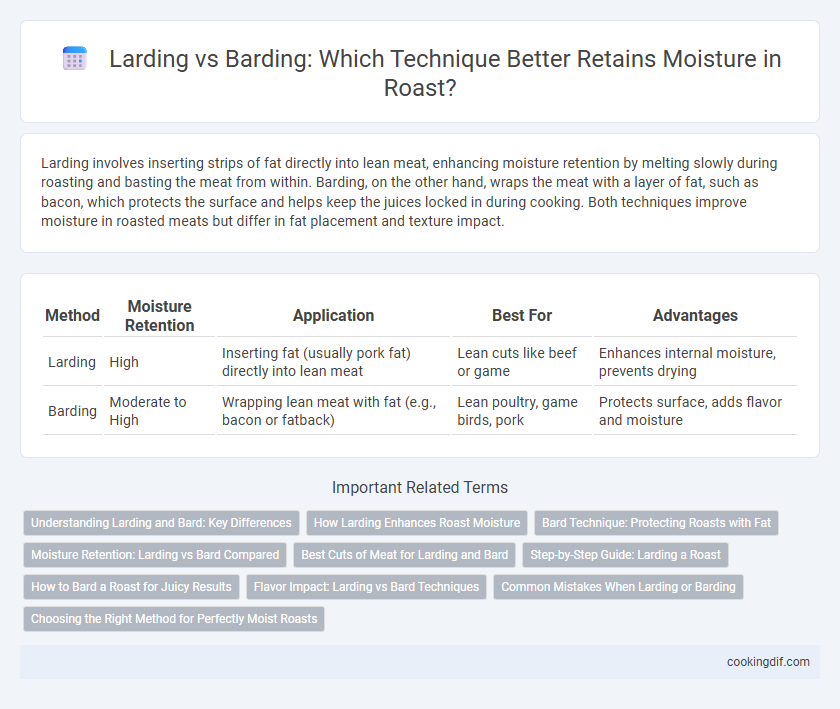Larding involves inserting strips of fat directly into lean meat, enhancing moisture retention by melting slowly during roasting and basting the meat from within. Barding, on the other hand, wraps the meat with a layer of fat, such as bacon, which protects the surface and helps keep the juices locked in during cooking. Both techniques improve moisture in roasted meats but differ in fat placement and texture impact.
Table of Comparison
| Method | Moisture Retention | Application | Best For | Advantages |
|---|---|---|---|---|
| Larding | High | Inserting fat (usually pork fat) directly into lean meat | Lean cuts like beef or game | Enhances internal moisture, prevents drying |
| Barding | Moderate to High | Wrapping lean meat with fat (e.g., bacon or fatback) | Lean poultry, game birds, pork | Protects surface, adds flavor and moisture |
Understanding Larding and Bard: Key Differences
Larding involves inserting strips of fat directly into lean meat to enhance moisture retention during roasting, whereas barding wraps the meat with an external layer of fat, such as bacon or fatback. Larding is especially effective for very lean cuts that tend to dry out, providing internal fat that melts and bastes the meat from within. Barding offers surface protection, creating a flavorful fat barrier that helps retain juiciness and develop a crisp outer texture.
How Larding Enhances Roast Moisture
Larding enhances roast moisture by inserting thin strips of fat directly into lean meat, which melts during cooking and bastes the meat from the inside, preventing dryness. This technique differs from barding, where fat is laid on the surface, providing external protection but less internal hydration. By delivering fat internally, larding ensures juicier, more succulent roasts with improved flavor and texture retention.
Bard Technique: Protecting Roasts with Fat
Barding involves wrapping roasts with a layer of fat, such as bacon or fatback, to protect the meat from drying out during roasting, ensuring enhanced moisture retention and rich flavor. This technique creates a barrier that prevents direct exposure to heat, preserving juiciness and tenderness in lean cuts like pork loin or poultry. Skilled use of barding improves overall roast quality, making it ideal for maintaining moist, succulent results.
Moisture Retention: Larding vs Bard Compared
Larding involves inserting strips of fat directly into meat, enhancing moisture retention by melting and basting the meat from within during roasting. Barding, which wraps lean cuts with an external layer of fat like bacon, also helps retain moisture by providing a protective barrier against drying. Both techniques improve juiciness, but larding offers deeper internal moisture infusion while barding primarily shields the outer surface.
Best Cuts of Meat for Larding and Bard
Larding and barding are two effective techniques for moisture retention during roasting, with larding involving inserting strips of fat directly into leaner cuts like beef tenderloin or pork loin, while barding wraps cuts such as poultry or game birds with external fat, like bacon or pork fat. The best cuts for larding include lean, tender muscles that lack intramuscular fat, which benefit from internal fat to stay succulent. Barding suits cuts with naturally thinner muscle layers or the potential to dry out, including whole chickens, turkey breasts, and venison roasts.
Step-by-Step Guide: Larding a Roast
Larding a roast involves inserting thin strips of fat directly into the meat using a larding needle, which enhances moisture retention by melting fat internally during cooking. This technique differs from barding, where fat is wrapped around the exterior, offering surface protection but less penetration of moisture deep inside the roast. For optimal juiciness, follow a step-by-step guide: select firm pork fat or bacon, soak your larding needle in cold water, carefully pierce the roast to insert the fat strips evenly, and ensure the fat reaches the center of the meat before roasting.
How to Bard a Roast for Juicy Results
To bard a roast for juicy results, carefully wrap thin strips of fatty bacon or pork fat around the meat, securing them with kitchen twine or toothpicks to ensure even coverage. This method infuses moisture and flavor as the fat slowly renders during roasting, creating a succulent outer layer that locks in juices. Ensure the roast surface is dry before barding to help the fat adhere properly and promote a crisp, flavorful crust.
Flavor Impact: Larding vs Bard Techniques
Larding infuses moisture and rich flavor directly into lean meats by inserting strips of fat, enhancing juiciness and mouthfeel during roasting. Bard techniques wrap the meat with an external fat layer, such as bacon or fatback, which slowly bastes the surface, creating a flavorful crust but less internal fat integration. Both methods improve moisture retention, yet larding delivers deeper, more intimate flavor infusion while barding primarily accentuates the outer taste and texture.
Common Mistakes When Larding or Barding
Common mistakes when larding or barding to retain moisture in roasting include using unevenly sized fat strips, which leads to inconsistent melting and poorly distributed juices. Over-inserting lard needles can damage the meat's texture, causing dry spots rather than preventing moisture loss. Improperly securing barding fat can result in slippage during cooking, reducing the effectiveness of the moisture barrier and leading to uneven roasting.
Choosing the Right Method for Perfectly Moist Roasts
Larding involves inserting strips of fat directly into lean meat, enhancing moisture retention by rendering fat internally during roasting. Bard, on the other hand, wraps the roast with external fat, such as bacon or pork fat, providing a protective barrier that prevents drying. Selecting larding or barding depends on the cut's fat content and desired texture to achieve perfectly moist roasts.
Larding vs Bard for moisture retention Infographic

 cookingdif.com
cookingdif.com